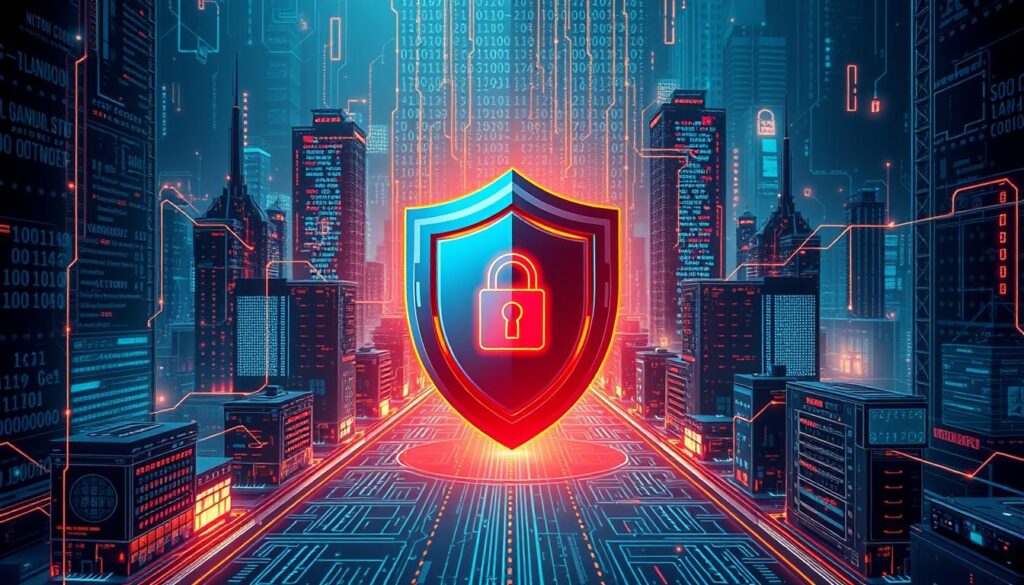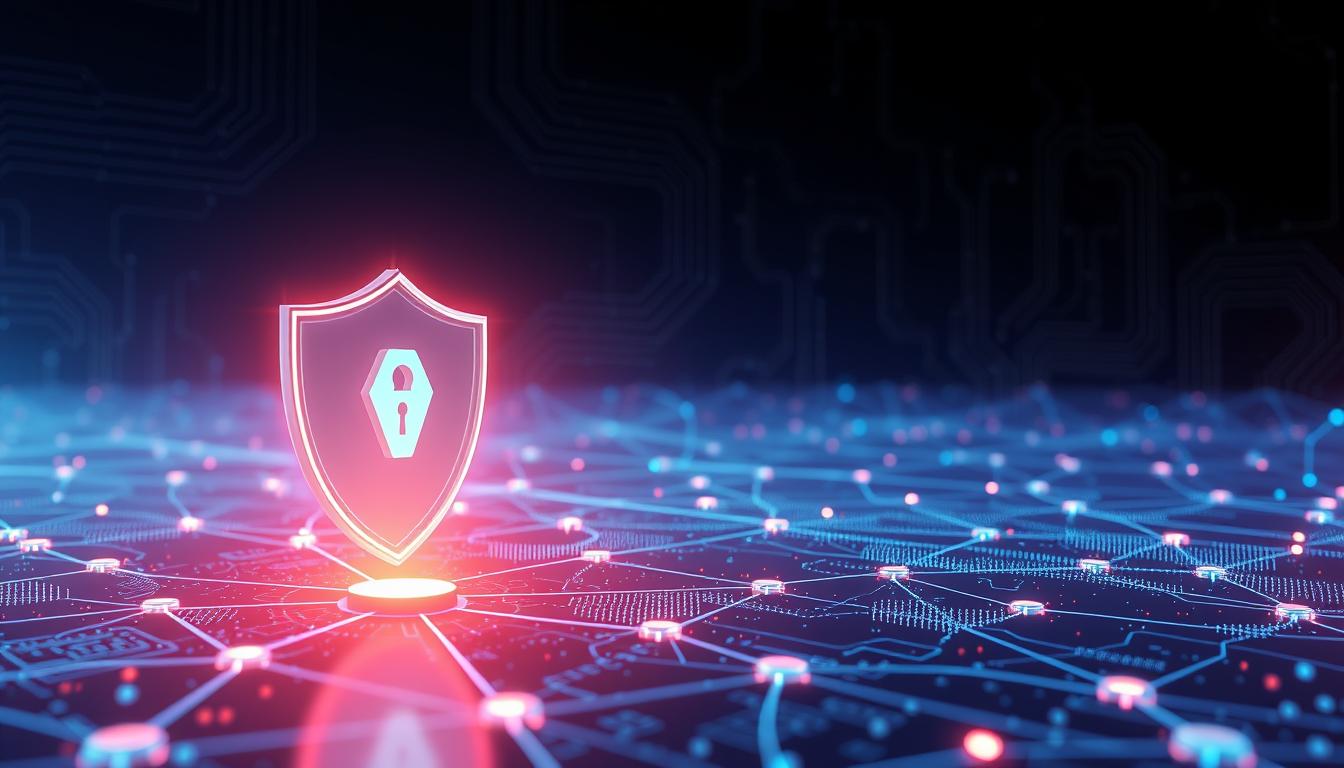In our increasingly interconnected world, the importance of cybersecurity cannot be overstated. As we rely more on digital technologies to manage our personal and professional lives, the need to safeguard our online presence and sensitive information has become paramount. This comprehensive article will delve into the essential aspects of cybersecurity, equipping you with the knowledge and strategies to protect your digital world.
From understanding the evolving landscape of cyber threats to implementing robust security measures, we’ll explore a wide range of topics that will empower you to navigate the digital landscape with confidence. Whether you’re an individual seeking to secure your personal devices and data or a business owner aiming to fortify your organization’s network, this article will provide you with the insights and tools necessary to mitigate the risks associated with cyber attacks.
Key Takeaways
- Gain a comprehensive understanding of the importance of cybersecurity in the digital age.
- Identify and address the various risks and threats that exist in the online realm.
- Learn strategies to strengthen your network security and safeguard your sensitive information.
- Discover proactive approaches to threat detection and incident response.
- Explore best practices for enhancing your overall cyber defences.
The Importance of Cybersecurity in the Digital Age
In today’s increasingly digital world, cybersecurity has become a critical concern for individuals and businesses alike. As our personal and professional lives become more intertwined with technology, the need to protect our digital assets has never been more paramount. From safeguarding sensitive data protection to ensuring the security of our network security, the importance of a robust cybersecurity strategy cannot be overstated.
Risks and Threats in the Online Realm
The online realm is fraught with a myriad of risks and threats, ranging from data breaches and malware to phishing attacks and identity theft. Cybercriminals are continually devising new and sophisticated methods to infiltrate our digital lives, putting our personal information, financial assets, and even our digital identities at risk. Staying ahead of these threat detection challenges requires a proactive and vigilant approach to vulnerability assessment.
The Consequences of Cyber Attacks
The consequences of a successful cyber attack can be severe, both for individuals and businesses. From financial losses and reputational damage to legal repercussions and the disruption of critical operations, the fallout can be devastating. In an increasingly interconnected world, the ripple effects of a cyber attack can extend far beyond the initial point of compromise, underscoring the importance of a comprehensive cybersecurity strategy.
“Cybersecurity is not just an IT problem – it’s a business problem. The stakes are too high, and the consequences too severe, to treat it as anything less.”
Strengthening Your Network Security
In today’s digital landscape, safeguarding your network security is paramount. By implementing robust access control measures, leveraging powerful encryption technologies, and conducting regular vulnerability assessments, you can fortify your digital defenses and protect your valuable assets from unauthorized access.
Robust Access Control Measures
Effective access control is the foundation of network security. Implement multi-factor authentication to ensure only authorized users can gain entry to your network. Regularly review and update user permissions, limiting access to sensitive information and critical systems. Continuously monitor user activities and promptly revoke access for terminated employees or suspicious behavior.
Encryption: Your Digital Fortress
Encryption is a powerful tool in the fight against cyber threats. Utilize robust encryption protocols, such as AES and RSA, to safeguard your data in transit and at rest. Encrypt sensitive communications, files, and databases to prevent eavesdropping and data breaches. Regularly review and update your encryption methods to stay ahead of evolving cryptographic vulnerabilities.
Vulnerability Assessments: Identifying Weaknesses
Regular vulnerability assessments are crucial for maintaining a secure network. Employ vulnerability scanning tools to identify potential entry points and security flaws within your system. Prioritize the remediation of high-risk vulnerabilities, and implement patch management strategies to keep your software and systems up-to-date. Continuously monitor your network for emerging threats and adapt your security measures accordingly.
By prioritizing network security, you can safeguard your digital assets, protect your organization from cyber attacks, and ensure the confidentiality, integrity, and availability of your critical information. Embrace a proactive approach to network security and stay one step ahead of the ever-evolving threat landscape.
| Measure | Description |
|---|---|
| Multi-factor Authentication | Require multiple forms of identification to verify user identity, such as a password, biometric data, or a one-time code. |
| Encryption Protocols | Utilize advanced encryption algorithms, such as AES and RSA, to protect data in transit and at rest. |
| Vulnerability Scanning | Regularly scan your network to identify security vulnerabilities and address them in a timely manner. |
“Cybersecurity is not just a technical challenge, but a strategic imperative for organizations in the digital age.”
Data Protection: Safeguarding Your Sensitive Information
In the digital age, safeguarding your sensitive information is paramount. From personal data to business-critical files, robust data protection measures are essential to mitigate the risks of cyber threats and unauthorized access. Two key components of effective data protection are encryption and access control.
Encryption: Masking Your Digital Footprint
Encryption is the process of converting your data into a coded format, making it unreadable without a specific decryption key. By implementing strong encryption techniques, you can protect your data from prying eyes and ensure its confidentiality. Encryption is a crucial safeguard against data breaches, helping to preserve the integrity and security of your sensitive information.
Access Control: Restricting Unauthorized Entry
Effective access control measures are crucial in limiting access to your data and systems. This may involve implementing multi-factor authentication, setting granular permissions, and regularly reviewing user access privileges. By controlling who can access your sensitive information, you can significantly mitigate the risk of data breaches and unauthorized activities.
Integrating robust encryption and access control strategies is a powerful approach to data protection. By implementing these measures, you can safeguard your digital assets and ensure the confidentiality, integrity, and availability of your sensitive information.
“Cybersecurity is not just an IT issue; it’s a business imperative. Protecting your data is essential for maintaining trust, reputation, and compliance.”
Remember, a proactive and comprehensive approach to data protection is crucial in the dynamic digital landscape. By staying vigilant and adopting best practices, you can empower your organization or personal digital life with enhanced security and peace of mind.
Cybersecurity: A Proactive Approach to Threat Detection
In the dynamic world of cybersecurity, staying one step ahead of threats is crucial. By adopting a proactive approach, organizations can enhance their overall cyber resilience and effectively navigate the ever-evolving landscape of digital risks. At the heart of this proactive strategy lies the importance of monitoring and incident response.
Monitoring and Incident Response Strategies
Continuous monitoring of your systems and networks is essential for timely threat detection. Implementing robust monitoring solutions can help you identify anomalies, detect potential security breaches, and respond promptly to mitigate the impact of cyber attacks. Alongside monitoring, effective incident response protocols are key to minimizing the damage and restoring normal operations in the event of a security incident.
- Leverage advanced threat detection and monitoring tools to stay vigilant against emerging risks.
- Develop comprehensive incident response plans that outline clear steps for investigation, containment, and recovery.
- Regularly test and refine your incident response strategies to ensure they remain effective and adaptable.
- Foster a culture of cybersecurity awareness and collaboration within your organization to enhance cyber resilience.
By implementing these proactive measures, organizations can strengthen their overall risk management capabilities and be better positioned to withstand and recover from potential cyber threats. Embracing this proactive approach is a crucial step towards securing your digital assets and safeguarding your organization’s future.
“Cybersecurity is not a one-time investment, it’s an ongoing journey of vigilance and adaptation.”
Risk Management: Identifying and Mitigating Vulnerabilities
In the digital age, effective risk management is a critical component of a robust cybersecurity strategy. By proactively identifying and addressing vulnerabilities within your systems and networks, you can significantly enhance your organization’s cyber resilience and reduce the risk of successful cyber attacks.
Conducting thorough vulnerability assessments is the first step in this process. These comprehensive evaluations allow you to pinpoint potential weaknesses, such as outdated software, misconfigured systems, or unpatched security flaws. Armed with this knowledge, you can then prioritize and implement targeted risk mitigation strategies to address these vulnerabilities and strengthen your overall cyber defenses.
Alongside vulnerability assessments, threat detection plays a crucial role in effective risk management. By closely monitoring your systems for signs of suspicious activity, you can swiftly identify and respond to potential threats, minimizing the impact and duration of any cyber incidents.
Ultimately, a holistic approach to risk management is essential for safeguarding your digital assets and ensuring the long-term resilience of your organization. By proactively addressing vulnerabilities and staying vigilant against emerging threats, you can navigate the complex cybersecurity landscape with confidence and protect your business from the devastating consequences of cyber attacks.
| Key Considerations for Effective Risk Management |
|---|
|
“Effective risk management is not about eliminating all risks, but rather about identifying, assessing, and mitigating those risks that pose the greatest threat to your organization.”
Cyber Resilience: Bouncing Back from Cyber Incidents
In today’s dynamic cyber threat landscape, building cyber resilience is essential for organizations of all sizes. Cyber resilience encompasses the ability to withstand, respond to, and recover from the impact of cyber attacks, ensuring business continuity and minimizing disruptions to operations.
Business Continuity and Disaster Recovery
Developing and implementing comprehensive business continuity and disaster recovery plans are crucial components of cyber resilience. These plans outline the strategies and procedures your organization will follow to maintain essential functions and recover critical systems and data in the event of a cyber incident.
- Business continuity planning focuses on identifying and prioritizing the most critical business operations, processes, and assets, ensuring seamless continuity during and after a cyber attack.
- Disaster recovery planning addresses the steps needed to restore and recover your organization’s technology infrastructure, data, and systems in the aftermath of a cyber incident.
By proactively addressing both business continuity and disaster recovery, you can enhance your organization’s ability to bounce back from cyber incidents, minimizing the impact on your customers, operations, and reputation.
| Key Considerations for Cyber Resilience | Business Continuity | Disaster Recovery |
|---|---|---|
| Critical Business Functions | Prioritize and maintain essential operations | Restore critical systems and data |
| Backup and Recovery | Ensure reliable backup mechanisms | Implement robust data recovery strategies |
| Communication and Incident Response | Establish clear communication protocols | Develop effective incident response plans |
By proactively addressing both business continuity and disaster recovery, you can enhance your organization’s ability to bounce back from cyber incidents, minimizing the impact on your customers, operations, and reputation.
“Cyber resilience is not just about preventing cyber attacks, but also about being able to recover and learn from them. It’s a mindset that embraces the reality of the threat landscape and prepares organizations to bounce back stronger.”
Best Practices for Enhancing Your Cyber Defenses
In today’s digital landscape, cybersecurity is a critical concern for organizations of all sizes. To fortify your defenses against cyber threats, implementing best practices is essential. At the heart of this approach lies the importance of employee training and security awareness programs.
Employee Training and Awareness Programs
Cybersecurity is not just the responsibility of your IT team; it requires a collaborative effort from every member of your organization. By empowering your employees with the knowledge and skills to recognize and respond to potential threats, you can significantly strengthen your overall security posture.
- Conduct regular cybersecurity training sessions to educate employees on the latest threats, such as phishing scams, ransomware, and data breaches.
- Implement security awareness campaigns to foster a culture of vigilance, encouraging employees to report suspicious activities and adhere to best practices.
- Simulate cyber incidents, such as phishing attempts, to test your employees’ ability to identify and respond to threats effectively.
Remember, cybersecurity is a shared responsibility. By investing in comprehensive employee training and awareness programs, you can reduce the risk of human-related vulnerabilities and enhance your overall cybersecurity best practices.
“The weakest link in any cybersecurity strategy is often the human element. Investing in employee training and awareness is crucial to strengthening your cyber defenses.”
Alongside employee training, it’s also essential to address vulnerability management within your organization. Regularly assessing and addressing vulnerabilities in your systems and software can help mitigate the risk of successful cyber attacks.
By adopting these best practices, you can empower your employees to become active participants in safeguarding your digital assets, fostering a culture of security awareness and resilience against cyber threats.
Emerging Trends and Technologies in Cybersecurity
The realm of cybersecurity is constantly evolving, with new cybersecurity trends and emerging technologies emerging at a rapid pace. By staying informed about these developments, organizations can better prepare themselves to adapt and respond to the ever-changing cyber threat environment.
One prominent trend in the cybersecurity landscape is the increasing adoption of cloud-based security solutions. As more businesses migrate their data and operations to the cloud, there is a growing need for robust cloud security measures to protect against data breaches and other cyber threats.
Another emerging trend is the use of artificial intelligence (AI) and machine learning in threat detection and vulnerability assessment. These technologies enable security systems to analyze vast amounts of data, identify patterns, and quickly detect and respond to potential threats.
Additionally, the rise of the Internet of Things (IoT) has introduced new security challenges, as connected devices can provide entry points for cyber attackers. Addressing the security vulnerabilities of IoT devices has become a growing focus in the cybersecurity industry.
| Emerging Technology | Application in Cybersecurity |
|---|---|
| Blockchain | Enhancing data integrity and secure transactions |
| Quantum Computing | Developing stronger encryption and decryption methods |
| Biometrics | Improving user authentication and access control |
As the cybersecurity landscape continues to evolve, organizations must stay vigilant and proactive in their approach to cybersecurity. By embracing these emerging technologies and trends, businesses can strengthen their cyber defences and better protect themselves against the growing cyber threats.
Partnering with Cybersecurity Experts
In the ever-evolving world of technology, navigating the complexities of cybersecurity can be a daunting task. Fortunately, partnering with cybersecurity experts can provide invaluable support and enhance your overall security posture.
The Benefits of Managed Security Services
Managed security services offer a comprehensive approach to protecting your digital assets. By leveraging the expertise and resources of specialized service providers, you can safeguard your organization from a wide range of cyber threats and ensure robust risk management and compliance measures are in place.
One of the key advantages of managed security services is the ability to focus on your core business activities while leaving the challenging task of cybersecurity to the professionals. These experts stay up-to-date with the latest security trends, technologies, and industry regulations, allowing you to stay ahead of the curve and mitigate potential risks effectively.
- Comprehensive threat monitoring and incident response
- Proactive vulnerability assessments and remediation
- Compliance management and regulatory guidance
- Dedicated security operations center and 24/7 support
By partnering with cybersecurity experts, you can elevate your organization’s security posture, safeguard sensitive data, and ensure business continuity in the face of evolving cyber threats. This strategic collaboration empowers you to focus on your core competencies while entrusting your digital security to experienced professionals.
“Cybersecurity is no longer an afterthought; it’s a strategic imperative for businesses of all sizes. Partnering with experts ensures your organization is prepared to combat the ever-changing landscape of cyber threats.”
Cybersecurity Compliance and Regulatory Requirements
In today’s digital landscape, maintaining compliance with cybersecurity regulations and standards is crucial for safeguarding your organization’s assets. Cybersecurity compliance ensures that your security measures align with industry-specific guidelines and legal requirements, mitigating the risk of hefty fines, legal repercussions, and reputational damage.
Organizations must navigate a complex web of regulatory requirements that dictate how they manage sensitive data, protect against cyber threats, and respond to security incidents. Failure to adhere to these guidelines can result in severe consequences, including penalties and loss of consumer trust.
Effective risk management and data protection strategies are at the heart of cybersecurity compliance. By proactively identifying and addressing vulnerabilities, organizations can strengthen their overall security posture and demonstrate their commitment to protecting customer information and critical infrastructure.
Understanding the Compliance Landscape
Navigating the compliance landscape can be a daunting task, as regulations vary across industries and jurisdictions. Organizations must stay informed about the latest cybersecurity compliance requirements, which may include:
- General data protection regulations, such as the EU’s GDPR
- Industry-specific standards, like the HIPAA for healthcare or PCI DSS for the financial sector
- National and regional cybersecurity frameworks, such as the NIST Cybersecurity Framework
| Regulation | Key Requirements | Potential Penalties |
|---|---|---|
| General Data Protection Regulation (GDPR) |
|
Up to 4% of global annual revenue or €20 million, whichever is greater |
| Health Insurance Portability and Accountability Act (HIPAA) |
|
Civil penalties of up to $50,000 per violation, with a maximum of $1.5 million per year |
By understanding and complying with these regulatory requirements, organizations can not only avoid legal and financial penalties but also strengthen their overall cybersecurity posture and build trust with their customers and stakeholders.
“Cybersecurity compliance is not just about avoiding fines – it’s about protecting your organization’s most valuable assets and maintaining the trust of your customers.”
Embracing a culture of cybersecurity compliance starts with a comprehensive assessment of your organization’s security measures and a commitment to continuous improvement. By staying vigilant and adapting to emerging threats and regulations, you can safeguard your digital assets and ensure the long-term success of your business.

Conclusion: Embracing a Cybersecurity Mindset
As we conclude our journey through the landscape of cybersecurity, it’s crucial to understand the importance of embracing a comprehensive cybersecurity mindset. By implementing the strategies and best practices we have discussed, you can foster a culture of cyber resilience, enhance the protection of your sensitive data, and strengthen your overall network security.
Remember, cybersecurity is an ongoing endeavor, and staying vigilant and proactive is key to navigating the evolving threats in the digital realm. Cultivating a cybersecurity mindset within your organization or personal digital life will empower you to make informed decisions, anticipate potential risks, and respond effectively to any cyber incidents that may arise.
Embracing this proactive approach to data protection and cyber resilience will not only safeguard your digital assets but also instill confidence in your ability to thrive in the face of the ever-changing cybersecurity landscape. By fostering a culture of cybersecurity awareness and continuous improvement, you can ensure that your organization or personal digital life remains secure and resilient in the years to come.



